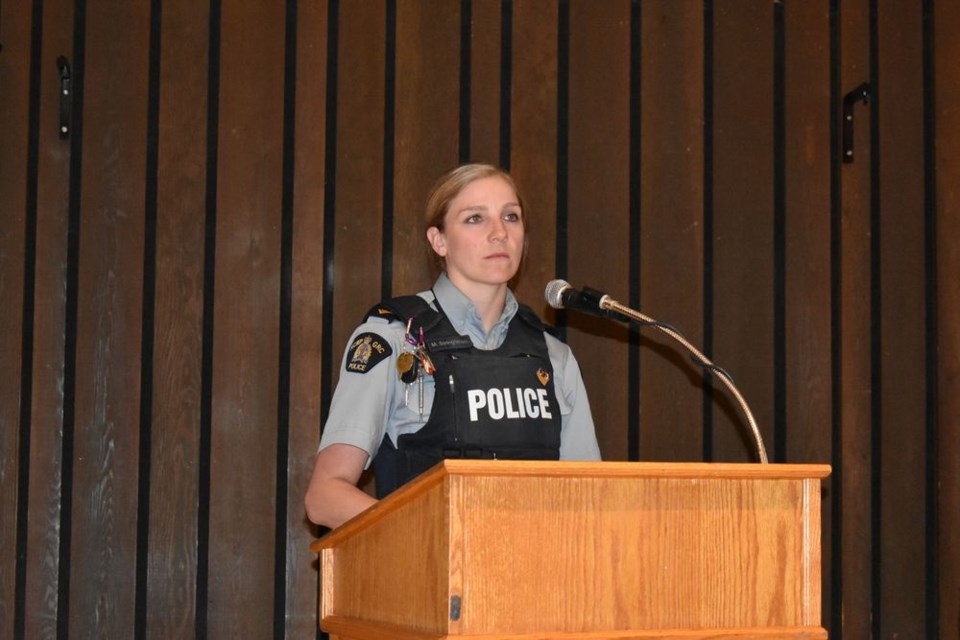After learning about recent detachment statistics and priorities, Kamsack residents had opportunity to discuss any concerns about community policing with Kamsack RCMP members during a town hall session last week.
Assisted by a slide presentation, Sgt. Meagan Stringfellow, the acting Kamsack detachment commander, who chaired the meeting at the OCC Hall on May 29, began the session by introducing the detachment members, supervisors and service assistants and said that S/Sgt Noel Allard, will be arriving after selling his current home.
Stringfellow told the meeting of nearly 50 people of the area’s boundaries which include the provincial forest to the north, the Manitoba border to the east, Wroxton to the south and a mile west of Hyas and Verigin to the west.
That’s about 1,800 square miles and the distance from the south to the north is 77 miles, she said.
The detachment had a total of 4,123 occurrences reported from May 28, 2018 to May 28, 2019, she said. Of those, 1,631, or 39 per cent, were in the town of Kamsack; 1,264 (30 per cent) were of the Cote, Keeseekoose and The Key First Nations, while l,228 (29 per cent) were in the rest of the rural areas which includes seven rural municipalities and 11 communities.
During that time there were 81 traffic collisions, 638 provincial traffic offences reported, with 306 traffic tickets written, and 55 impaired driving investigations with 33 impaired driving charges.
The year included 423 other provincial statutes, including sudden deaths; 408 crimes against persons with 230 charges laid; 751 crimes against property with 137 charges laid, and 47 drug related complaints with 18 charges laid.
“We need you to report crime,” she said. “We can’t help if we don’t know about it.”
Stringfellow explained that receiving reports from members of the public helps the detachment make decisions as to how and where its resources are deployed.
“We can’t allocate resources to a problem we don’t know exists. If we are going to be successful at crime prevention, we need community engagement and support.”
She outlined other responsibilities of members, including attending court, visiting schools, attending parades and assisting other organizations and talked about the detachment’s cell block which employs 10 guards to look after 250 prisoners this year to date.
“Last year we held 644 prisoners.”
Stringfellow introduced the four priorities of Mark Fisher, the commanding officer of “F” Division which are: community engagement; effective and efficient service delivery; employee health wellness and safety, and leadership and leadership development.
The provincial priorities for 2019-2020 are: crime reduction; traffic safety; prevent, detect, deter, respond to and solve criminal activity in relation to serious crime and organized crime, and to effectively contribute to the long-term wellness and safety of Aboriginal communities through an inclusive and culturally competent police service.
The annual performance plan at Kamsack is concentrating on traffic so as to contribute to the provincial plan for safe roads, she said. Members maintain open communication and transparency with partners in the communities they serve by targeting areas that have seen an increase in property crimes or criminal activities and strive to ensure all members have a respectful work place.
Crime prevention initiatives include encouraging residents to safeguard valuables and outbuildings; remove keys from vehicles; photograph valuables and record serial numbers; to stay observant and watch out for one’s own and neighbouring properties; to report crime and other suspicious activity to police and encourage them to not attempt to subdue or pursue suspects.
She talked about Everbridge, the new tool used by detachments to send credible and timely police advisories to Saskatchewan residents when the public’s assistance is needed to prevent or solve crimes and encouraged everyone to sign up for the service.
Members of the audience who were encouraged to ask questions of the several members present, asked about the difference between the Everbridge program and Crimestoppers.
Mayor Nancy Brunt responded to a question about landlords and tenants who tend to move from one house to another in spite of having caused problems at each location. Former mayor Rod Gardner suggested that more police visibility in the downtown core might be a detriment to crime, while others complained about loitering.



